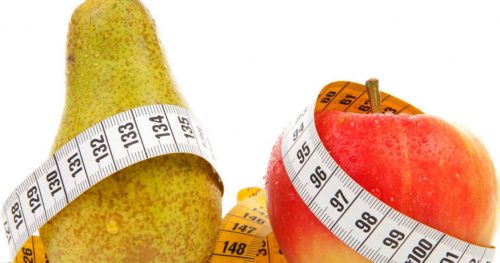A person whose body has a pear shape is likely to be healthier than somebody whose body has an apple shape. This is what a team of researchers from the University of California – Riverside (UCR) has found.
The human body naturally accumulates fat, whether we like it or not. For females, it usually builds up around the hips. Hence, women’s bodies have a pear shape when they become overweight.
For males, fat accumulates around the abdomen. Hence, men’s bodies have an apple shape when they become overweight.
If you are overweight, it is, therefore, healthier to have a pear shape than an apple shape.
Djurdjica Coss and colleagues wrote about their study and findings in the journal Frontiers of Immunology (citation below). Coss, who was study leader, is an Associate Professor of Biomedical Sciences in the UCR School of Medicine.
Apple vs. pear shape – animal study
The research team carried out an animal study. They found that only the male mice experienced neuroinflammation or an immune-system response activation in the brain after being on a high-fat diet.
The high-fat diet, on the other hand, did not affect the female mice in the same way. The males also showed reduced sperm count, low testosterone, and neuroinflammation.
Clinical studies have led scientists to believe that ovarian estrogen protects females when they are young. They have assumed that women gain weight after the menopause due to a steep and rapid decline in estrogen. This subsequently leads to a decline in health parameters, such as obesity.

Prof. Coss said:
“We addressed this assumption by removing ovaries in young mice. We found that the mice proceed to gain weight when fed a high-fat diet, suggesting that ovarian hormones are indeed protective against weight gain.”
“But we found, too, that these female mice exhibit neither neuroinflammation, nor changes in reproductive hormones, suggesting that they are protected by factors other than ovarian estrogen. This is a novel finding.”
Obesity leads to declining fertility
Prof. Coss believes that their findings from this animal study probably have applications in humans.
Prof. Coss said:
“Mice on high-fat diet develop metabolic syndrome – a constellation of pathologies that includes Type 2 diabetes and insulin insensitivity – similarly to obese humans.”
“Obese men have lower testosterone levels, contributing to low libido, low energy, and reduced muscle strength. We see this in mice, too; obese male mice showed nearly 50 percent decreases in testosterone and sperm number. Obese women have difficulty with their menstrual cycles. They don’t ovulate.”
“Obese female mice show the same, contributing to decreased fertility. Interestingly, 18 percent of couples in the United States now need medical interventions – hormonal treatments, in vitro fertilization – to conceive a child. Obesity is a likely factor.”
In the United States, obesity is a public health concern. More than thirty percent of Americans are obese while over two-thirds are overweight.
Obesity has been linked to an increased rate of stroke and mental decline. It may also lead to other problems that affect the internal organs.
Obesity affects some minority groups in the US disproportionately.
Obesity and a body with a pear shape
Female humans and mice deposit fat differently from male humans and mice.
Females deposit fat right below the skin, i.e., subcutaneously. Males, on the other hand, build up feet deeper. Specifically in the body’s visceral region, where it may affect the internal organs.
In other words, if you are obese and have a body with a pear shape, you are less likely to have internal organ complications.
However, even in women, the abdominal regions eventually begin to show obesity. This is due to fat overwhelming the subcutaneous regions. Excessive fat in the abdominal region subsequently leads to neuroinflammation.
Regarding visceral fat and the organs in that region, Prof. Coss said:
“We know that abdominal fat – that is, fat around visceral organs – gets more inflamed with a fat overburden. This fat then recruits immune cells from blood circulation that get activated.”
Macrophages cross the blood-brain barrier
The researchers also found that peripheral immune cells cross the blood-brain barrier, especially macrophages. The blood-brain barrier is a protective barrier that stops most compounds from getting into the brain.
This infiltration of macrophages and peripheral immune cells into the brain occurs as well as the activation of resident immune cells.
Prof. Coss said:
“The brain has been considered an ‘immune protected site,’ but we show that peripheral inflammation ‘spills over’ into the brain, which, in turn, may cause neuronal problems mentioned above.”
The researchers explained that they don’t know what causes this activation. They plan to carry out additional research to find out.
Regarding possible causes, Prof. Coss said:
“We know the immune cells secrete cytokines, which are inflammatory markers, in the blood. It’s possible these cytokines travel in blood from the fat tissue and activate the immune cells to cross the blood-brain barrier.”
“It’s possible, too, that other immune cells contribute to the neuroinflammation. Clearly, our work has provoked several research questions we would like to answer.”
As far as patients are concerned, weight is a sensitive topic, regardless of whether they have an apple or pear shape.
Prof. Coss said:
“After all, we associate food with happiness, social interactions, and family gatherings. Still, my advice is: ‘Watch your diet! And keep an eye on body weight, particularly around the abdomen.'”
Citation
“Diet-Induced Obesity Elicits Macrophage Infiltration and Reduction in Spine Density in the Hypothalami of Male but Not Female Mice,” Nancy M. Lainez, Carrie R. Jonak, Meera G. Nair, Iryna M. Ethell, Emma H. Wilson, Monica J. Carson, and Djurdjica Coss. Front. Immunol., 11 September 2018 | https://doi.org/10.3389/fimmu.2018.01992.

